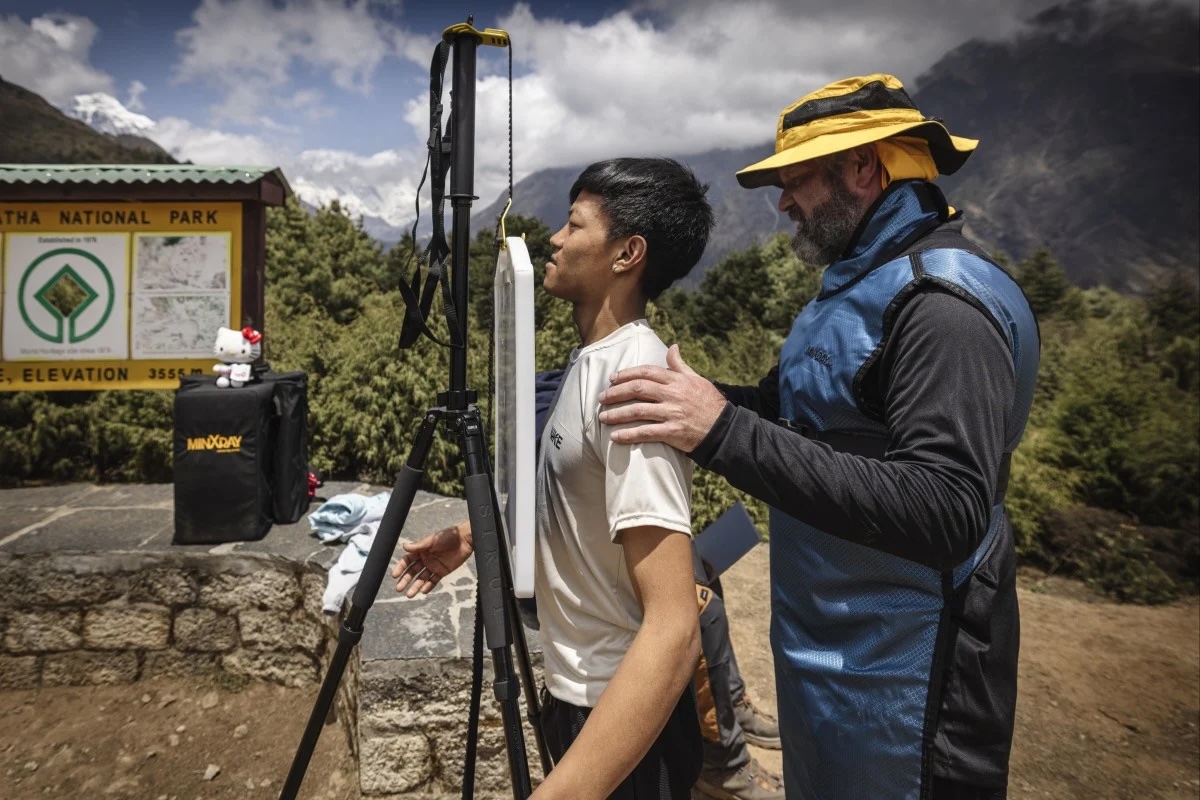AI and X-Ray Technology Revolutionize Healthcare in Nepal's Remote Regions

At the peak of Kala Patthar, 5,500 meters above sea level, Jacob Cresswell, the team leader for the United Nations Stop TB program, lifted several layers of clothing to place a freezing laptop against his bare stomach to warm it up. Twenty minutes later, with the help of a power bank, the laptop was powered up again, and the world record attempt was back on track. This record attempt is currently under review by Guinness World Records.
One of the Sherpas in the team held an object resembling a whiteboard against his chest, while another man aimed an espresso-sized machine at his back and began performing an X-ray. The board collected the data and transmitted it to the AI-embedded laptop. A message appeared half a minute later, indicating that the screening was complete. Without AI, this process would have required a radiologist and taken several hours.
The group of health professionals considered their expedition in May a success. Their goal was to demonstrate that AI-equipped portable X-ray machines, each weighing around 25 kg, could operate in some of the world's most remote locations. This technology, already commercially available worldwide, is seen as key to eradicating tuberculosis (TB), a major health problem in many developing countries.
Mikkel Broholt, Director of Operations at Stop TB and a member of the expedition, stated that many people with the disease go undetected and unknowingly risk spreading it.
“To eradicate TB, we need to screen more people. If we can carry an X-ray machine to a peak in the Himalayas, you can take it anywhere,” Broholt said.
AI has long promised to make healthcare more accessible, with chatbots in automated administration systems helping to free up valuable time for doctors and nurses. Google's Chief Health Officer, Karen DeSalvo, has likened AI to the discovery of penicillin, calling it “the most transformational opportunity of our lifetime to advance human health” at the World Health Assembly in Geneva.
One of the first market-ready AI applications in healthcare is computer-assisted diagnostics. Such technology is already being used for preliminary screenings in some developed countries and is increasingly being deployed in developing countries where, due to a lack of radiologists, AI is expected to have a significant impact on healthcare services.
In the waiting room of a hospital in Lukla, Nepal, 63-year-old Pasang Yangji lay asleep on a heavy wooden bench. Suffering from TB, she often falls asleep easily and for long hours. “I come here every day for treatment,” she says in a barely audible voice. In the Khumbu region, coughing is so common that it’s called the “Khumbu cough.”
Pasang Yangji contracted TB from her husband in 2017 and underwent two months of treatment. However, the daily hospital visits prevented her from working, so she stopped going. Three months ago, her symptoms worsened, and she resumed treatment.
In Khumbu's rugged terrain, there is only one doctor for every 150,000 people. For screening, people need to travel to Kathmandu, a costly and time-consuming journey that risks patients losing their jobs. Even in the capital, resources are scarce, with only 150 radiologists available to analyze X-ray images for a population of 29 million.
“With new technologies like ultraportable X-rays equipped with AI, we can quickly screen people and determine which cases are normal and which are abnormal,” Broholt said. “It not only eliminates the need to travel to big cities but also reduces the dependency on highly trained medical personnel for TB screening.”
Stop TB has been deploying AI-equipped portable X-ray devices in various countries over the past few years. This technology has already screened hundreds of thousands of people, detecting several thousand abnormal chest X-rays.
Broholt is excited that the technology is soon to be rolled out on a larger scale. “TB is the world’s largest infectious disease killer, disproportionately affecting marginalized communities. AI represents an opportunity to invest in health equity.”
In Nepal, Broholt and his team donated their X-ray machine to a local hospital, where healthcare professionals have been trained to use it, primarily for TB screening but also for other injuries. “What matters now to further this development is a question of resources and political will.”
(This material is originally written by Per Liljas in South China Morning Post and subject to copyright.)

![From Kathmandu to the World: How Excel Students Are Winning Big [Admission Open]](https://nepalaaja.com/img/70194/medium/excel-college-info-eng-nep-2342.jpg)
